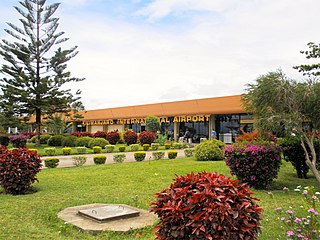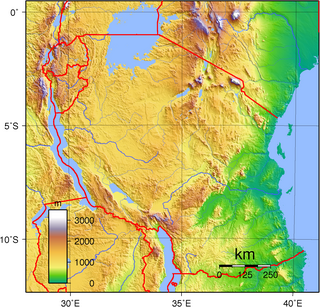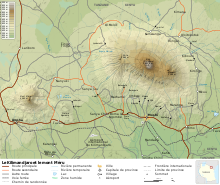
Tanzania, officially the United Republic of Tanzania, is a country in East Africa within the African Great Lakes region. It borders Uganda to the north; Kenya to the northeast; the Indian Ocean to the east; Mozambique and Malawi to the south; Zambia to the southwest; and Rwanda, Burundi, and the Democratic Republic of the Congo to the west. Mount Kilimanjaro, Africa's highest mountain, is in northeastern Tanzania. According to the 2022 national census, Tanzania has a population of nearly 62 million, making it the most populous country located entirely south of the equator next to South Africa.

Tanzania comprises many lakes, national parks, and Africa's highest point, Mount Kilimanjaro. Northeast Tanzania is mountainous, while the central area is part of a large plateau covered in grasslands. The country also contains the southern portion of Lake Victoria on its northern border with Uganda and Kenya.

Kilimanjaro International Airport (KIA) (IATA: JRO, ICAO: HTKJ) is an international airport located in Hai District, Kilimanjaro Region, Tanzania. The airport serves the cities of Arusha and Moshi. The airport handled 802,731 passengers in 2014 and mainly serves regional flights as well as a few long-haul services due to its importance as a leisure destination. It is the largest airport in northern Tanzania, by size and passenger volume.

Arusha City is a Tanzanian city, with a population of 617,631, and the regional capital of the Arusha Region, with a population of 2,356,255.

Moshi is a municipality and the capital of Kilimanjaro region in the north eastern Tanzania. As of 2017, the municipality has an estimated population of 201,150 and a population density of 3,409 persons per km2. In the last official census of 2022, the municipality had a population of 221,733. The municipality is situated on the lower slopes of Mount Kilimanjaro, a dormant volcano that is the highest mountain in Africa. The name Moshi has been reported to refer to the smoke that emanates from the nearby mountain. The municipality covers about 59 square kilometres (23 sq mi) and is the smallest municipality in Tanzania by area.

Kilimanjaro Region is one of Tanzania's 31 administrative regions. The regional capital and largest city is the municipality of Moshi. With the 3rd highest HDI of 0.640 in the country, Kilimanjaro is one among the top five most developed regions of Tanzania. According to the 2012 national census, the region had a population of 1,640,087, which was lower than the pre-census projection of 1,702,207. For 2002–2012, the region's 1.8 percent average annual population growth rate was the 24th highest in the country. It was also the eighth most densely populated region with 124 people per square kilometer. The most well-known tribes in the Kilimanjaro region are the chagga, rombos, and pare.

The International School of Tanganyika (IST), founded in 1963, is an international school in Dar es Salaam, Tanzania. The school is an IB World School that hosts the Primary Years, Middle Years, and Diploma programmes. IST operates on two campuses in desirable suburbs of Dar es Salaam, Tanzania. IST Elementary serves children from age 3 to Grade 5 while IST Secondary, 5 kilometers away, serves Grades 6 – 12. IST is fully accredited by the Council of International Schools (CIS) and the Middle States Association (MSA).

United World College East Africa (UWCEA) is an independent international school in Tanzania, and a member of the United World Colleges movement. Established in 1969 as International School Moshi, the school is based on two campuses on the slopes of Mount Kilimanjaro and Mount Meru near the city of Moshi, the capital of the Kilimanjaro region in north eastern Tanzania.
Erasto Bartholomeo Mpemba (1950–2023) was a Tanzanian game warden who, as a schoolboy, discovered the eponymously named Mpemba effect, a paradoxical phenomenon in which hot water freezes faster than cold water under certain conditions; this effect had been observed previously by Aristotle, Francis Bacon, and René Descartes.

The following outline is provided as an overview of and topical guide to Tanzania:
The Usambara Railway was the first railway to be built in German East Africa and what is today Tanzania.

Tanzania is a country with many tourist attractions. Approximately 38 percent of Tanzania's land area is set aside in protected areas for conservation. There are 17 national parks, 29 game reserves, 40 controlled conservation areas and marine parks. Tanzania is also home to Mount Kilimanjaro, the highest point in Africa.

Patrick Miller Hemingway is an American wildlife manager and writer who is novelist Ernest Hemingway's second son, and the first born to Hemingway's second wife Pauline Pfeiffer. During his childhood he travelled frequently with his parents, and then attended Harvard University, graduated in 1950, and shortly thereafter moved to East Africa where he lived for 25 years. In Tanzania, Patrick was a professional big-game hunter and for over a decade he owned a safari business. In the 1960s he was appointed by the United Nations to the Wildlife Management College in Tanzania as a teacher of conservation and wildlife. In the 1970s he moved to Montana where he managed the intellectual property of his father's estate. He edited his father's unpublished novel about a 1950s safari to Africa and published it with the title True at First Light (1999).

Tanzania contains some 20 percent of the species of Africa's large mammal population, found across its reserves, conservation areas, marine parks, and 17 national parks, spread over an area of more than 42,000 square kilometres (16,000 sq mi) and forming approximately 38 percent of the country's territory. Wildlife resources of Tanzania are described as "without parallel in Africa" and "the prime game viewing country". Serengeti National Park, the country's second largest national park area at 14,763 square kilometres (5,700 sq mi), is located in northern Tanzania and is famous for its extensive migratory herds of wildebeests and zebra while also having the reputation as one of the great natural wonders of the world. The Ngorongoro Conservation Area, established in 1959, is a UNESCO World Heritage Site and inhabited by the Maasai people. Its Ngorongoro Crater is the largest intact caldera in the world.
The African Wildlife Foundation (AWF) is an international conservation organization dedicated to the preservation of Africa's wildlife and wild lands. AWF aims to protect the continent's wild lands as well as its wildlife and natural resources.

Coffee production in Tanzania is a significant aspect of its economy as it is Tanzania's largest export crop. Tanzanian coffee production averages between 30,000 and 40,000 metric tons annually of which approximately 70% is Arabica and 30% is Robusta.

Beer and alcohol is an integral part of Tanzanian society and local brands hold a strong sense of national pride among the Tanzanian population. There is a considerable amount of brewing and drinking done in the country. Tanzania ranks 6th in Africa for beer consumption and contributes to over 3% of the African consumption. However, over 90% of the national consumption is either homemade or from the informal sector. Bottled beer is expensive for the majority of the population and is almost 6 times more expensive than the maize beers. Nonetheless, beer sales and taxes are a vital part of the Tanzanian economy.

Mainland Tanzania refers to the part of Tanzania on the continent of Africa; excluding the islands of Zanzibar. It corresponds with the area of the former country of Tanganyika.

Lucy Lameck was a Tanzanian politician, who was the first woman to hold a Ministerial post in the government. Born to a farming family, she trained as a nurse before becoming involved in politics and attending Ruskin College, Oxford, through a scholarship. She first entered the Tanganyika National Assembly in 1960, before being elected to the Tanzania National Assembly in 1965. With the exception of 1975 to 1980, she continued to hold a seat there until her death in 1993. She is seen as a role model, having worked throughout her life to improve conditions within the country for women.

















